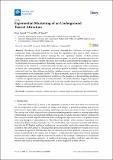Files in this item
Experiential marketing of an underground tourist attraction
Item metadata
| dc.contributor.author | Garrod, Brian | |
| dc.contributor.author | Dowell, David | |
| dc.date.accessioned | 2020-11-16T15:30:16Z | |
| dc.date.available | 2020-11-16T15:30:16Z | |
| dc.date.issued | 2020-08-09 | |
| dc.identifier | 271265935 | |
| dc.identifier | 9e53cc90-bc60-49d6-b00f-4d7becb6a936 | |
| dc.identifier | 85096116966 | |
| dc.identifier.citation | Garrod , B & Dowell , D 2020 , ' Experiential marketing of an underground tourist attraction ' , Tourism and Hospitality , vol. 1 , no. 1 , pp. 1-19 . https://doi.org/10.3390/tourhosp1010001 | en |
| dc.identifier.issn | 2673-5768 | |
| dc.identifier.other | Jisc: 0ac82294b20b46aeb0f78fc50e6eed7c | |
| dc.identifier.other | ORCID: /0000-0003-4788-5240/work/83889981 | |
| dc.identifier.uri | https://hdl.handle.net/10023/20987 | |
| dc.description.abstract | The theory of the ‘experience economy’ contends that consumers no longer achieve satisfaction from consuming products but from the experiences they receive while doing so. Producers should therefore actively manage the four experience ‘realms’ of their product offerings—entertainment, education, aesthetics and escapism—to provide optimal experiences for their customers. In the case of tourist attractions, however, there is insufficient direct empirical evidence to substantiate this recommendation. This study therefore sets out to test the notion of the experience economy in the context of a tourist attraction—in this case, an underground visitor experience in Wales, UK—using partial least squares structural equation modelling. Alternative models are estimated based on three different mediating variables—arousal, memory and satisfaction—with revisit intention as the dependent variable. The analysis finds that none of the four experience realms are significant predictors of revisit intention in all three of the models, even though all three mediating variables are significant predictors of revisit intention. The results therefore suggest that optimal customer experiences do not necessarily need to be built equally upon all four experiences realms. Rather, a customised approach is required to optimise the customer experience for specific products consumed in particular contexts. | |
| dc.format.extent | 19 | |
| dc.format.extent | 793483 | |
| dc.language.iso | eng | |
| dc.relation.ispartof | Tourism and Hospitality | en |
| dc.subject | Experience economy | en |
| dc.subject | Visitor attraction | en |
| dc.subject | Arousal | en |
| dc.subject | Memory | en |
| dc.subject | Satisfaction | en |
| dc.subject | Revisit intention | en |
| dc.subject | HD28 Management. Industrial Management | en |
| dc.subject | NDAS | en |
| dc.subject.lcc | HD28 | en |
| dc.title | Experiential marketing of an underground tourist attraction | en |
| dc.type | Journal article | en |
| dc.contributor.institution | University of St Andrews. School of Management | en |
| dc.identifier.doi | 10.3390/tourhosp1010001 | |
| dc.description.status | Peer reviewed | en |
This item appears in the following Collection(s)
Items in the St Andrews Research Repository are protected by copyright, with all rights reserved, unless otherwise indicated.

